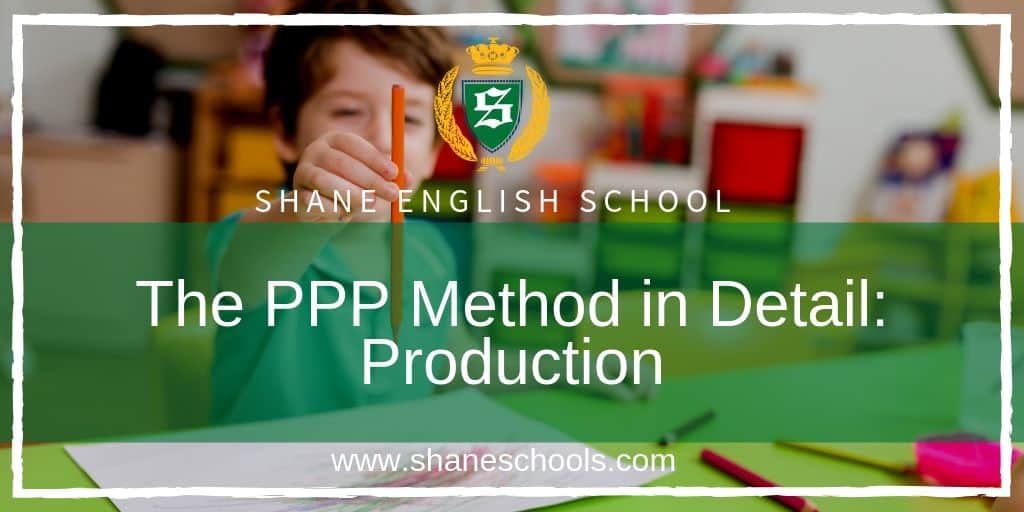The PPP method’s production phase is the third and final stage. It often includes games and activities give students some structure while using target language.A language production game/activity is one that allows the students to freely produce the language that has just been practiced. Never ask the student to produce something that you haven’t let them practice, i.e. if you have been teaching and drilling the answer form, the production game should focus on the answer form.
This is the third stage of the Presentation-Practice-Production method (or the PPP method for short). Click here for an overview of the PPP method. Alternatively, you can also read the detailed introductions to the Presentation phase and the Practice phase.
There are a few major considerations when planning a production game or activity;
- Whole Class Participation
- Setting up
- Safety
- Relevance to target language
- Interaction patterns (should be student to student)
Younger students need games with slightly more structure, whereas older students can be trusted with true freer activities.
Use picture prompts in production activities; the students should not be able to read full sentences anywhere. If they are reading, they are not producing.
Below are some ideas for activities, grouped for level.
PPP Method: Production for Younger and Lower-level Learners
In the PPP method production phase, it’s important to give students the building blocks for the target language.
Whispers – The students have to pass a question down the line, with the final student running to find the answer somewhere in the classroom, e.g. a flashcard face down on the floor at the front of the room. This is a race between the two teams.
Questions down the line – One team complete activity such as build a tower, write something, or draw stars on the board while the other team has to do questions and answers down the line.
Naughts and crosses or other two person game – Put students in pairs. They have to deliver a question or answer before they can take their turn. Give them picture prompts to ensure the quality and relevance of the language produced.
Flashcard guess – This can be achieved through the teacher holding flashcards to their chest or by having them on the board then turning them round. Or students have the flashcards and have to guess what the other students have. If they answer correctly they win the card.
Information gap mill drill – Both teams lack information, they must question members of the other team to fill out their own sheet. Use picture prompts rather than written ones to encourage real production.
PPP Method: Production for Older and Higher-level Students
Older and more advanced students in the PPP method’s production stage need some structure, such as in the following activities. It’s important for the teacher to take a step back and just monitor the students progress rather than offering too much guidance.
Paper-scissor-stone card giveaway – Students all have x number of cards, they have to ask and answer a question then play paper, scissor, stone, and the winner gets a card from the loser.
Hot potato – The students must ask and answer questions while throwing and catching an object. Repetitions can be forbidden to encourage more language.
Stop the bus – This can be used for review or have one question but various letters that have to be in the response (e.g, Student 1: What animals do you like? Student 2: ‘I like snakes, crocodiles, birds and lions’). The first team to produce x number of sentences wins. This can be altered for any level or language ability.
Writing race – The students race to write a story. Give them picture prompts and do some mind-mapping first to get the most out of this one.
Who am I? – One student chooses a character and the other students have to take turns asking questions to find out who they are. This can require additional vocabulary, so is better for older students.
20 questions – Very similar to “Who am I?” above but the students can also choose objects, places, emotions etc. This can require additional vocabulary, so is better for older students)
Backs to the wall – 2 students have their backs to the wall and on the wall is a picture or sentence. The other students must describe what is on the wall without using the exact language or name of the item.
Find someone who – Give the students a list of things related to today’s target language, and they must walk around the class finding people who connect with it. For example, on the list is “sushi”, if today’s TL is “Have you ever” they could walk around and ask “Have you ever eaten sushi?”, if the TL is “would like” they walk around and ask “Would you like some sushi?”.
Survey – These are very similar to above, although they don’t have to be related to personal accomplishments.
A version of this article originally appeared in Shane English School’s Teaching English to Young Learners (TEYL) program, which is part of new teachers’ orientation.

We're hiring!
With schools around the world, Shane English School always has exciting new opportunities to offer.


